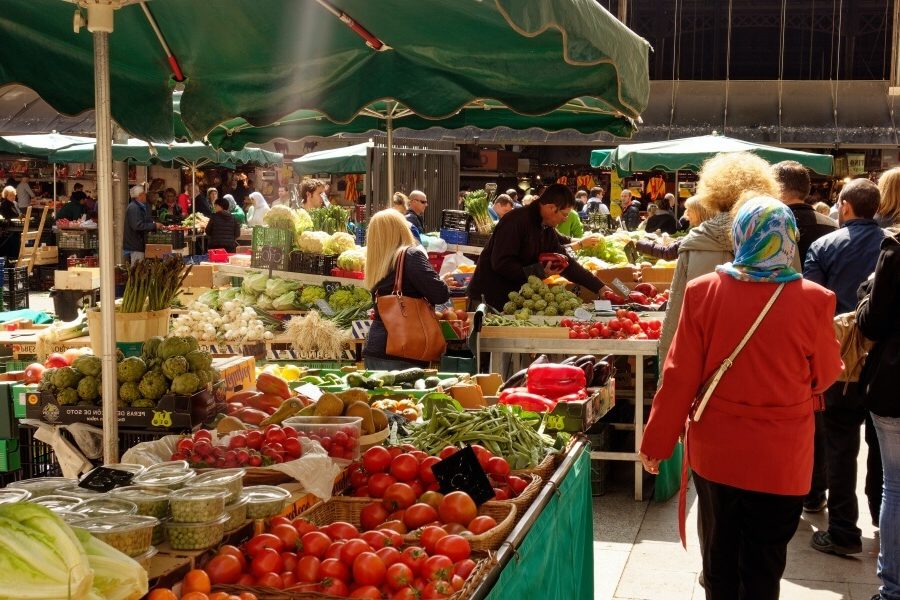
Tips to Make Buying Local a Lifestyle Habit
Why Eat What’s Down the Street: Part 2
How you can start buying local today
In part one of Why Eat What’s Down the Street, we looked at the importance of sourcing local produce, in addition to the health implications of modern food production and transportation. Which brings us to part two: How do you start buying and eating locally-sourced goods? What should you expect? And, how do you make buying local a lifestyle habit?
Let’s talk about four common hesitations many people have about buying and sourcing locally to better understand where to go, what to expect, and how to start purchasing locally today.
1.) “I don’t know where to go to find the nearest farmer’s market or other local food sources.”
Local farms and other food sources might not be as visible as grocery stores, which conveniently sit on most street corners. However, Arizona is teeming with farmer’s markets, local farms, local meat and dairy options, and local food artisans. For example, there are hundreds of local food sources in Maricopa County alone.
Good Food Finder, an initiative by Local First Arizona, makes it easy to find local options that are both close to home and that deliver. You can shop by region to meet local farmers and learn more about the vibrant food system in your community.
2.) “I’m used to going to the grocery store to buy what I need; farmer’s markets are intimidating.”
We’re creatures of habit, and society has made it very convenient to drop by the nearby grocery store for food. But as we learned in part one of our blog series, store-bought produce is riddled with pesticides and herbicides that are harmful to our health.
People with the healthiest guts in the world (which is a direct reflection of a person’s overall health) eat 30 different plant foods a week, including various herbs and spices. Farmer’s markets offer a seasonal assortment of plant foods, making it easy to achieve variety in your diet.
Vendors and farmers are also much more invested in their products since the business is often their own. Because they’re invested in local, quality goods, they are regularly willing to talk to you about the product, how you can use it, and its nutritional benefits, a value not offered at the grocery store. Shopping at a farmer’s market offers an opportunity to form relationships with your local vendors and farmers and trust their advice. In turn, this makes buying food enjoyable.
3.) “Farmer’s markets and other local vendors are expensive.”
According to a 2017 plan by the Arizona Hungry Advisory Council, “1 in 6 Arizonans is affected by food insecurity and an alarming 500,000 Arizonans will face a diet-related disease by 2030.” To combat this issue, there are several local, state, and federal programs in place to ensure fresh produce and healthy food choices are affordable and available.
Take Double Up Food Bucks, for instance. The national nonprofit has an Arizona-specific program: For every dollar spent with a SNAP/EBT card, you get $1 to spend on Arizona-grown fruits and vegetables, dried beans, and edible plants and seeds with no daily limit.
There are also:
- Donation-based vendors at local markets like the TigerMountain Foundation
- Federally-funded programs like Emergency Food Assistance Program to supplement food families, individuals, the elderly, and low-income households
- Produce cooperatives, such as Sun Produce, where you can add local products to your bag, use SNAP benefits, and select a pick up location
- And, Community Supported Agriculture (CSA) delivery options.
4.) “Farmer’s markets are limited, and I can buy everything I need at the grocery store.”
You may be surprised to know that many local vendors now sell a wide variety of goods, including jams/jellies, dried beans and grains, condiments, ready-to-eat meals, meats, dairy products, soap, flour and more. Of course, there may still be a few items that you prefer to purchase in-store, but we encourage you to give it a try and strive for local produce. When you’re ready to make a change, the 80/20 rule is a good rule-of-thumb to work up to: 80% of the food you purchase should be sourced locally, while 20% can be from the store.
Buying and sourcing locally-grown food can be far more fun than weaving in and out of the grocery store. We hope you’ll consider making the farmer’s market a weekly or every-other-week occasion with friends and family to strengthen your connection to your local community, try new things, and get outside!
WellStyles and Valley Schools
If you enjoy this type of information and would like to learn more about WellStyles, a wellness program exclusive to Valley Schools, reach out to us. We’d love to hear from you!



